
|
|

October 7, 2005
WTIC 1080/WTIC-FM 96.5, Avon, Connecticut, part II
By SCOTT FYBUSH
There are legendary sites out there in the world of AM radio, to be sure, and we've had some neat opportunities over the last decade and a half to visit them and to share them with you here on Tower Site of the Week.
But as far as we know, there is nowhere in the United States that's been home to a 50 kilowatt AM transmitter for as long as this week's featured site, the WTIC (1080) transmitter plant at 375 Deercliff Road in Avon, Connecticut. Not only has this site housed a powerful AM facility since 1929, it's also the only 50 kW AM site we can think of that's also home to full-power TV (two analog, two digital) and FM stations. Add to that the big, fat Blaw-Knox towers out back, plus the insulated (!) self-supporting TV tower, and best of all the fact that the history of the site has been lovingly preserved for three-quarters of a century, and it's no wonder that our June visit to the site consumed the better part of an afternoon.
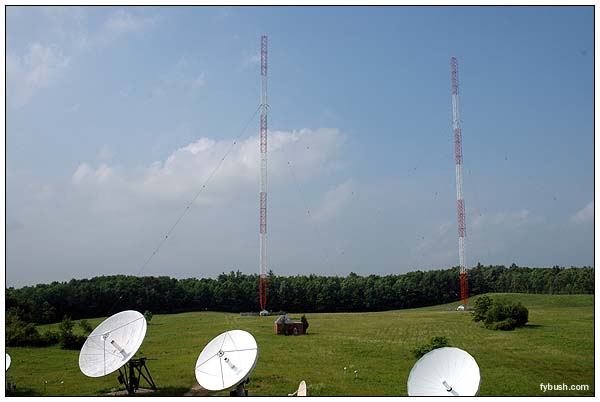
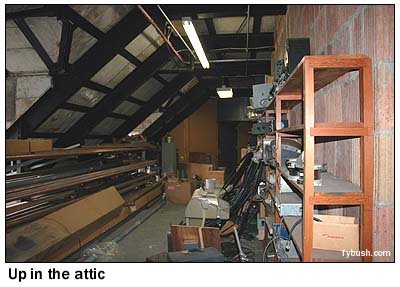 In
part one of our visit, presented here last week, we showed you
the inside of the building that was built in 1929 to house "Old
Number One," the early RCA 50 kilowatt transmitter that
powered WTIC's signal for almost three decades.
In
part one of our visit, presented here last week, we showed you
the inside of the building that was built in 1929 to house "Old
Number One," the early RCA 50 kilowatt transmitter that
powered WTIC's signal for almost three decades.
Today, it's home to transmitters for four stations - WTIC, WTIC-FM, WFSB-TV and WFSB-DT - but it's also home to plenty of history, especially up in the attic...
There's more up here than just spare transmission line and obsolete gear.
There are also filing cabinets stuffed with engineering paperwork from back in the day, including lots of letters to neighbors of this site offering assistance with overloaded receivers (for which Travelers offered to install a filter, albeit with a signed document reminding the receiver owner that the filter remained WTIC property!)
Then there are those "other" letters. Take, for example, that letter below, written on Feb. 10, 1931, to one Mrs. E. B. Doolittle of New Haven, just one of hundreds of carbon copies of replies to engineering correspondence. Here's what it says:
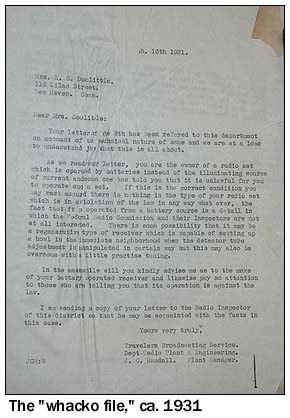 Dear
Mrs. Doolittle:
Dear
Mrs. Doolittle:
Your letter of the 9th has been referred to this department on account of the technical matter of same and we are at a loss to understand just what this is all about. As we read your letter, you are the owner of a radio set which is operated by batteries instead of the illuminating source of current and some one has told you that it is unlawful for you to operate such a set. If this is the correct condition you may rest assured there is nothing in the type of your radio set which is in violation of the law in any way what ever. the fact that it is operated from a battery source is a detail in which the Federal Radio Commission and its Inspectors are not at all interested. There is some possibility that it may be a regenerative type of receiver which is capable of setting up a howl in the immediate neighborhood when the detector tube adjustment is manipulated in certain way but this may also be overcome with a little practise tuning.
In the meanwhile will you kindly advise me as to the make of your battery operated receiver and likewise pay no attention to those who are telling you that its operation is against the law.
I am sending a copy of your letter to the Radio Inspector of this distrct so that he may be acquainted with the facts in this case.
Yours very truly,
Travelers Broadcasting Service, Dept-Radio Plant & Engineering, J.C. Randall, Plant Manager
Neat stuff, and we could easily spend a whole day looking through the files, but there's still much more to see. So after snapping some photos looking back at the two-tower AM array (you see one at the top of the page, and you'll likely see it again in the 2007 Tower Site Calendar), it's time to head out into the sun and see what awaits us out at the towers.
Directly behind the building is the 554-foot self-supporting tower that carries WFSB-TV (Channel 3) and WFSB-DT (Channel 33). Look carefully at the base - as we told you last week, this tower is more than just your average TV tower. Those are clusters of insulators (four, if memory serves) at the base of each leg. Insulating the tower not only makes it easier to detune the tower at 1080 - it also makes it possible to tune the tower up at 1080 for auxiliary use, fed by that Gates Five that we showed you in Part One.
The arrival of DTV brought some changes to this tower a few years back, as the old channel 3 antenna was removed and replaced with a new stacked antenna that has 33 at the top and 3 just below. Who's that paying his respects to the old antenna? It's our pal Mike Fitzpatrick, proprietor of the excellent NECRAT tower-picture site! (And, yeah, that's a Yankees cap he's wearing, at the very transmitter facility we depend on for our Red Sox fix all summer long. Sheesh...)
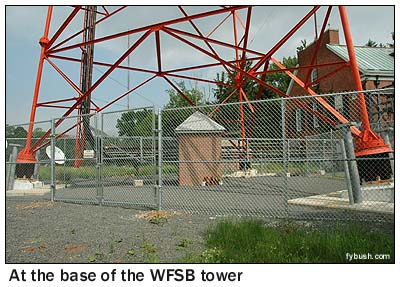
|
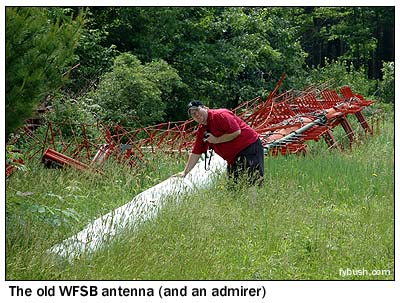
|
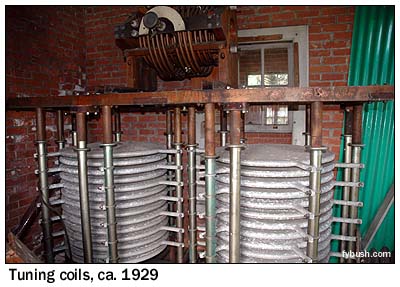 We'll
get all the way out to the current 1080 towers in just a bit,
but first we have another brush with history.
We'll
get all the way out to the current 1080 towers in just a bit,
but first we have another brush with history.
You may recall that when this site was built in 1929, it used a center-fed flat-top antenna. The tuning house for that antenna still stands, halfway back from the transmitter building to the towers, and it's been sitting more or less untouched for some 65 years since being replaced by the current two-tower directional array.
Those are the original open-air capacitors there (thanks to Tom Ray for identifying these relics!) - and the little brick building also houses some of the meters and controls from the Westinghouse HG50 that replaced "Old Number One" and was in turn replaced by the Continental 317C2 we showed you last week.
A further trek through the grass brings us to one of the bases from the original towers that supported the old flat-top. Today, it's pretty much just a clump of tall grass and shrubbery, but a careful look shows that beneath all that brush still sits one of the searchlights that illuminated the old tower. What a sight that must have been in the Connecticut night in the mid-thirties!
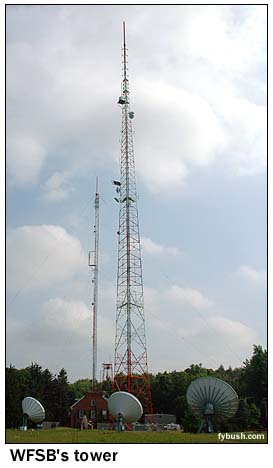
|
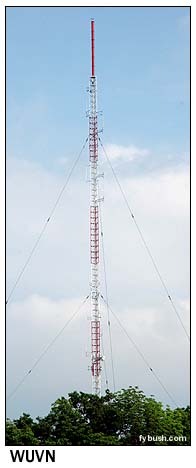
|
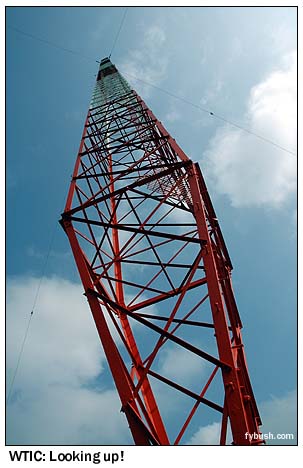
|
From here, it's a straight shot back to the two big (440') Blaw-Knox towers that carry the 1080 signal out to the world (they were once about 50 feet taller, but were shortened to better match WTIC's frequency when it moved from 1040 to 1080), but we'll pause for just one more moment before we get there. Looking back at the transmitter building, we see the WFSB-TV tower whose base we were observing earlier. Out beyond the building, we can also see the 454-foot guyed tower that carries the other stations at this site, WEDH (Channel 24), WTIC-FM and WWUH (91.3).
Looking across Deercliff Road to the east, there's still another tower nearby. Now owned by Pinnacle Towers, this one carries WUVN (Channel 18), the Univision station in town. This area has been home to channel 18 for decades, all the way back to the station's early days as WGTH-TV, an early testbed for subscription TV. The station was briefly a CBS O&O in the mid-fifties, taking the calls WHCT, and it struggled along under those calls for decades, first as an independent and then as one of Dr. Gene Scott's religious outlets. Dr. Scott lost the license (there's a story that he buried the channel 18 transmitter in a giant pit on the property to hide it from creditors), the station became an indie again, and by the early nineties it was bankrupt and dark before reemerging as a Spanish-language outlet. The current channel 18 site dates to the early eighties; before that, channel 18 was at another location a half-mile or so to the south. (That facility was built by the old General Teleradio for what was to have been WONS-FM 102.9, a station that never went on the air. Instead, WONS 1410 merged with the defunct WTHT 1230 to create WGTH radio, and from that was spawned WGTH-TV - and thanks to Bill Dillane for that brush with ancient Hartford history!)
But we digress...we're here to see WTIC, and now we find ourselves right at the bases of these mammoth towers.
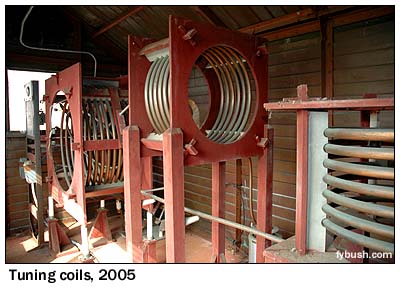
|
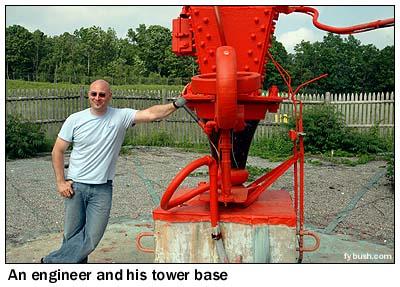
|
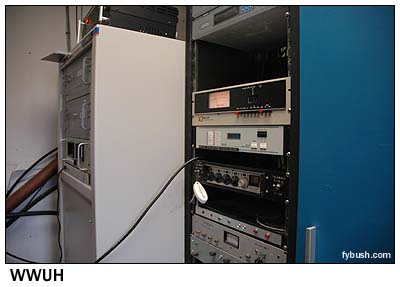 Even
for a 50 kilowatt station, those are some mighty big tuning coils,
and not without reason: in 1939, there was every reason to expect
that 50 kilowatts was just an interim power level en route to
even greater superpower operation, and so all the RF plumbing
here, nicely shielded by those copper-lined walls, is ready to
handle 500 kilowatts. (If only...)
Even
for a 50 kilowatt station, those are some mighty big tuning coils,
and not without reason: in 1939, there was every reason to expect
that 50 kilowatts was just an interim power level en route to
even greater superpower operation, and so all the RF plumbing
here, nicely shielded by those copper-lined walls, is ready to
handle 500 kilowatts. (If only...)
The west tower (at left in the photo at the top of the page) is the day tower, used for nondirectional operation until Dallas sunset, and so our host, WTIC chief engineer Jeff Hugabone, can safely get up close and personal with the east tower up there. (Don't try this at home...)
There are still two more stations at this site that we haven't fully explored. One is Connecticut Public TV's flagship WEDH (Channel 24), whose transmitter sits in a big garage-like structure just south of the WTIC/WFSB transmitter building. The CPTV engineers weren't around, so we didn't get to see the inside of that one.
(It won't matter in a few years, anyway; even though WEDH's analog signal has been out here since its 1962 sign-on, WEDH-DT will be over at Rattlesnake Mountain in Farmington when it finally gets on the air, and eventually WEDH will disappear from this site entirely.)
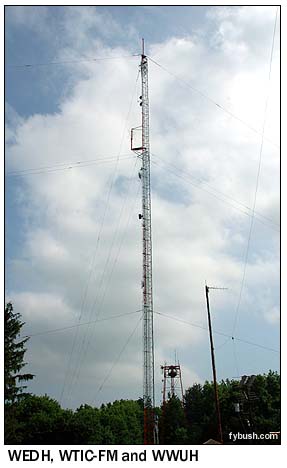 The
WEDH antenna sits at the top of the 454-foot tower that we saw
from a distance before. Below it, and pretty hard to see in this
picture (check out Mike's NECRAT site for some close-ups), is
an ERI 2-bay panel antenna that serves as WTIC-FM's main antenna.
The
WEDH antenna sits at the top of the 454-foot tower that we saw
from a distance before. Below it, and pretty hard to see in this
picture (check out Mike's NECRAT site for some close-ups), is
an ERI 2-bay panel antenna that serves as WTIC-FM's main antenna.
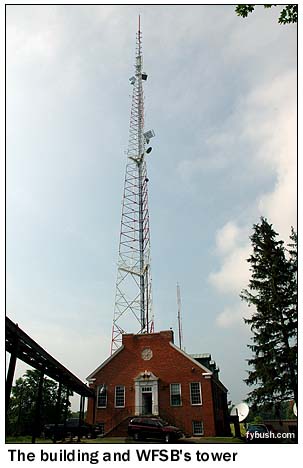 Below
that is a 2-bay ERI sidemount antenna in radomes, and that one
lives a double life.
Below
that is a 2-bay ERI sidemount antenna in radomes, and that one
lives a double life.
Most of the time, it's the main antenna for WWUH (91.3 West Hartford), the University of Hartford's eclectic FM station.
The WWUH transmitter is a Harris Z2CD of recent vintage; that blue door at the right edge of the picture above is a Harris FM2.5K used for backup purposes.
WWUH has to vacate that ERI antenna when WTIC-FM needs to use it as its aux, and when that happens, WWUH shifts to a 3-bay antenna that's mounted on that short tower (it once held a radar installation, and was once about three times as tall as it is now, with an antenna on top that might have been a WEDH backup) to the right of the big stick.
And with that, we bid adieu to this fascinating and historic site that's been home to so much radio and television for nearly eighty years...and head out to the West Coast for some Northern California tower fun. See you next week!
JUST RELEASED - it's your very first chance to order the 2006 Tower Site Calendar! Click here for ordering information!
- Previous Site of the Week: WTIC, Avon CT (part I)
- Next Week: KGO, San Francisco
- Site of the Week INDEX!
- How can you help support Site of the Week? Click here!
- Submit your suggestions for a future Site of the Week!
